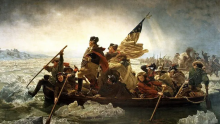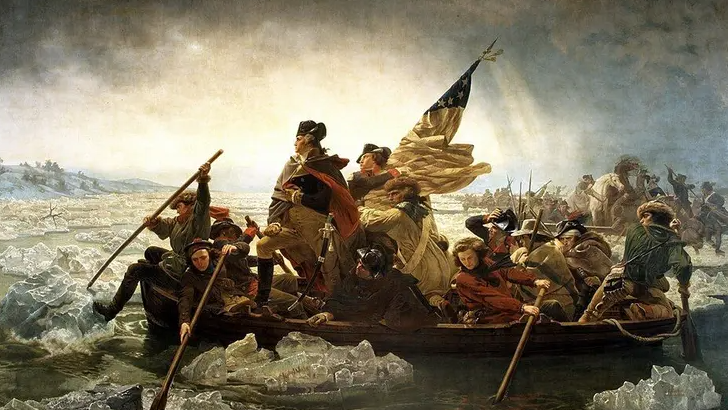
by Simone H, Year 12
When faced with this question, one must first set out what is meant by ‘individual ambition’ and ‘structural forces’. For the purpose of this article I shall define individual ambition as the changes made by an individual (simple enough) and structural forces as changes made due to long term factors for example economic conditions, political institutions and geographical factors.
Firstly I’d like to explore the shaping of history from individual ambition honing in this investigation onto three main characters: Adolf Hitler, George Washington and Issac Newton. Each person arguably had a huge impact on history and the world as it was. Adolf Hitler, famously the man responsible for the ‘final solution’, came to power in Germany in 1933 with headstrong plans and ideology. A lesser evil than the holocaust but still a destruction caused by Hitler was the ruination of the country’s democratic institutions. Almost as soon as power was in his palm, the Fuhrer passed the legislation of the Enabling Act (March 1933) and two years later reintroduced conscription (1935). This substantially set Germany up as a war state, aggravating the globe both politically and socially. Now with dictatorial power, Hitler was free to pass his military over the Polish border and ultimately fast track the world into another world war. The actions of this genocidal vegetarian led to the deaths of 50-70 million ‘Untermenschen’ (‘subhumans’), soldiers and civilians. Aside from this, Hitler and World War Two also caused the destruction of land globally and geographical changes. Notably, on the retreat of the Russian on their own soil a ‘scorched earth’ policy was set into motion meaning the fleeing troops destroyed fertile land, infrastructure, anything the enemy could utilize. The defacing of Russian land meant that many, during and after the war, fell victim to famine and homelessness which presumably led to more blood on Hitler’s hands. Additionally, the Austro-Hungarian Empire was reshaped in separated countries including Romania, Italy and Poland receiving additional land. Not only were borders changed in Europe, both the Middle East and Africa were dealt geographical change. The Ottoman Empire was reduced down to practically what Turkey is today and countries such as Iraq and Lebanon were dealt out for British and French control. Africa faced a similar fate with Germany losing control of its colonies and it being surrendered to League of Nations mandates as well as a multitude of border changes. Hitler’s authoritarian actions resulted in mass death, civil destruction and geopolitical distortion shaping much of the mid-20th century.
150 years prior, a man well-known was beginning to make his own waves in history: George Washington rose to power in 1775 when he was chosen as Commander-in-Chief of the Continental army during the revolutionary war. He was a key figure in the defeat of the British and the gaining of American Independence allowing America to set itself up as a republic nation. Even though this sounds positive, America was still weak; with no national army, newborn politics and the issue of taxes and legislates. In 1789, setting a historic record with 100% of votes, George Washington became America’s first president. Washington was humble, only serving two terms and setting in the records what the role of president ensued. He played a vital role in the making of the first cabernet which in turn created the sacred U.S Constitution. Overall, Washington was the forefront role model for how Presidency should be handled: he defined democratic leadership and, with his humble stepping down, established the peaceful transition of power which should take place.
Straying slightly from politics, I’d like to take your focus to another historic character. Isaac Newton, an English polymath, played a serious role in the Enlightenment and the revolution of science in the early modern period. Most will be familiar with Newton’s Laws of Motion, especially if you have read one of my previous articles ;) , and some may have heard of Newton’s publication of Philosophiæ Naturalis Principia Mathematica. These two played a monumental role in physics at the time and arguably still do. His book unified and authenticated the physics behind earth and space, replacing speculation with proved maths which is still being used today. Without Newton’s discoveries and proof, the road to scientific enlightenment would have been even longer with many essential discoveries and inventions having been delayed, Also the foundations and progression of physics and calculus would have been unstable and fragmented.
As found by our investigation into the Individual, they have had a huge responsibility in triggering historic turning points and progressing the world into what it is today. They have shaped history both in terms of politics and nations as well as science.
Now turning to the investigation to structural forces. Themes run often throughout history and here I will talk through the impact of three: economics, politics and geography. Economics underlines most historic events with tax being history’s biggest agitator, most famously aligned with trade and industrialisation money has moved history since the beginning. The establishment of agricultural industries and the obtaining of wealth has been the backbone of many founding nations such as America and Australia. The American Colonies, when still part of the British Empire, were restricted in their manufacturing rights as Great Britain was keen to uphold Mercantilism and the transaction of raw materials and processed goods. Many acts were passed to protect British producers and secure British industries. This made the settlements turn to cash crops to fuel economic independence and accumulate wealth. As Australia turned from a land of convicted criminals to independent settlements many struggled with the land and climate. They figured out that the secret to success in the vast lands of the Outback was not crops or minerals but instead a fluffy friend. Sheep farming boomed in Australia with the land being ideal for grazing sheep. The wool from the Merino Sheep was classified as high quality and was exported to the British factories where it would be woven into fine clothes. This industry created an incredibly independent elite class named ‘squatters’ who poached the indigenous land for their sheep. Without the agricultural export of sheep, Australia would not be the independent nation it is today and its impact can be valued on the phrase still used today: ‘Australia rode on the sheep’s back’. To demonstrate briefly the influence of taxes I draw your attention to a list of historical events arguably caused by taxes: American Revolution, the French Revolution, Peasant’s revolt, the Indian salt march, Roman tax revolts, English Civil war, Poll tax riots, French farmers revolt…I think you get the idea. Progressing to the second structural force, Politics - especially in the more modern eras - is at the centre of most changes. The creation of political parties including extremist groups and the extension of the franchise has caused huge historical waves. For instance, Lenin’s communist party which has shaped most of Russia’s modern history due to its instigation of terror, economic depressions and dictatorships. The extension of the franchise challenged traditional voting patterns with more opinions being displayed in the ballot box. This allowed parties such as Labour and Liberal to hold office and reshape national efficiency and what governments prioritize.
Our last structural force to be explored here is geography. This is often overlooked when reviewing history but it has played a large role in many historic affairs. The geography of the American Plains shaped how colonies survived, interacted with the natives and progressed their nation to independence. For example, the harsh climates and uncooperative soil forced the Mormon settlement of Salt Lake City to design irrigation systems to source crops. In addition mapping and borders has caused huge tensions throughout history including conflicts such as the Franco-Prussian War (1870-1871) or something more present, the Russian-Ukraine War. The tensions of territory can be seen throughout history, originating from tribal and indigenous land claims (around 65,000 years ago) to the 2025 Cambodian-Thai border crisis.
Looking into the influence of structural forces, we can see that history is constantly influenced by various thematic conditions and that each event, although the individual has played a vital role, has still been on the course of a structural force.
Using all examples presented previously I come to the conclusion that structural forces have shaped history more due to their persistent presence in any historic affair. The individual is not to be dismissed though and can still be highly regarded in the path of history but the endurance of themes means that structural forces emerge from this essay victorious.





















